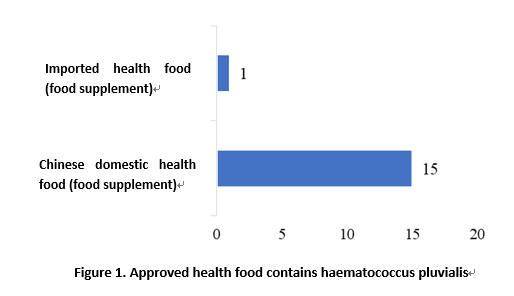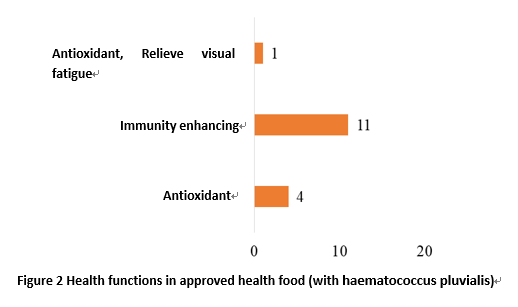1. What is Haematococcus pluvialis?
Haematococcus is a freshwater unicellular green algae belonging to Chlorophyta, Volvox, Haematococaceae, Haematococcus. The algae can accumulate a large amount of astaxanthin and looks red, hence the name of Haematococcus, also known as Haematococcus pluvialis.
In nutrient-limited or unfavorable environments, the photosynthetic rate of Haematococcus is unbalanced with the utilization rate of photosynthetic products, resulting in the accumulation of carbohydrates, fatty acids and carotenoids, especially the rapid accumulation of astaxanthin. Compared with natural sources such as Phaffia (0.4%), Pacific krill (0.012%), and Arctic shrimp (0.12%), the content of astaxanthin in Haematococcus pluvialis spores can reach up to 5%. Because Haematococcus spores are rich in astaxanthin, it became another high-value economic microalgae after Spirulina and Chlorella.
As we all know, astaxanthin has strong antioxidant properties and efficient free radical scavenging ability, and astaxanthin is widely used in food additives, cosmetics, health products, aquaculture and medicine and other fields. As these fields continue to develop, the demand for astaxanthin increases. As the best source of natural astaxanthin, the development of Haematococcus pluvialis industry has attracted much attention.
2. Approved use of Haematococcus pluvialis and related ingredients in China
1) On October 29, 2010, the former Ministry of Health issued the No. 17 Notice, approving Haematococcus pluvialis as a "new food ingredient". The scope of use does not include food for infants and young children, and the consumption should be less than or equal to 0.8 g/day; the production process is to select and breed high-quality Haematococcus pluvialis algal species for artificial cultivation, harvest Haematococcus pluvialis spores, and undergo wall breaking and drying processes. Production.
2) On March 12, 2021, the authority had included Haematococcus pluvialis oil (astaxanthin oil) in the new food raw material termination review catalog. Its scope of use does not include food for infants and young children; calculated by the total astaxanthin in Haematococcus pluvialis, the edible amount of Haematococcus pluvialis oil is ≤240 mg/day; The food safety index refers to the vegetable oil in my country's current national food safety standards implementation of the relevant regulations.
3. How does Astaxanthin (the active ingredient in Haematococcus pluvialis) work?
Astaxanthin is a lutein pigment that is commonly found in animals, plants, algae and microorganisms. It was first discovered in lobsters and is also known as astaxanthin. Astaxanthin is a carotenoid, which is mainly produced by plants and microalgae in nature. Animals cannot synthesize carotenoids and they can only obtain it from plants or algae through the food chain.
Results of the study show that astaxanthin provides various benefits to human. Astaxanthin is an excellent antioxidant, and its ability to quench the activity of reactive oxygen species in cells and scavenge free radicals in cells is more than 10 times higher than that of β-carotene, and more than 100 times stronger than vitamin E. Astaxanthin can increase the number of immune cells and inhibit the cytokine storm or inflammatory storm caused by excessive immune response, thereby enhancing the body's immunity. Ultraviolet radiation is an important cause of epidermal aging, and astaxanthin can effectively remove oxygen free radicals in cells and reduce the accumulation of senescent cells, protect skin health and delay skin aging. There are high concentrations of polyunsaturated fatty acids and high concentrations of oxygen in the retina, and the central nervous system is rich in unsaturated fatty acids and iron, which are highly susceptible to oxidative damage. Astaxanthin can cross the blood-brain barrier and quench damaging reactive oxygen species, thereby maintaining eye health.
4. Application of Haematococcus pluvialis in health food ( dietary supplement)
As mentioned above, in 2010, Haematococcus pluvialis was approved as a new food ingredient in China, and its application scope is food and health food (dietary supplement). Since then, a number of health food formulas containing Haematococcus pluvialis have been approved.
As of June 15, 2022, 16 types of health food containing Haematococcus pluvialis have been approved, among which 15 are Chinese domestic food supplements and 1 is imported food supplement, as shown in figure 1 below.
Health care functions mainly focus on boosting immunity and antioxidants, as shown in figure 2 below. The approved dosage forms mainly include tablets (2 types) and capsules (14 types involved).


5. Points for attention in the registration and application of Haematococcus pluvialis products
1) Enterprises need to emphasize the scientific side of product formulation and pay attention to product research and development process.
For example, when Haematococcus pluvialis is formulated with the traditional Chinese medicine, it should be provided from the perspective of traditional Chinese medicine theory and modern medical research to provide the scientific basis such as product formula compatibility and dosage theory, literature basis and experimental data.
2) At present, the public's cognition of "astaxanthin" is much higher than the total nutrient composition of "Haematococcus pluvialis", so the domestic and foreign researches on
“Haematococcus pluvialis" are mostly focused on the research and application of "astaxanthin". Therefore, enterprises should pay attention to the source and production process of "astaxanthin" mentioned in the literature and “Haematococcus pluvialis "when searching for scientific basis.
3) According to the feedback from the China authority concerning astaxanthin, astaxanthin oil
products belong to Haematococcus pluvialis and should comply with the requirement of the former Ministry of Health on Haematococcus pluvialis.
If they are not from the Haematococcus pluvialis, they should not be used in food production.
Therefore, enterprises should be clear about the source of astaxanthin, and only astaxanthin from Haematococcus pluvialis can be used in food or health food (food supplement).
6. Conclusion
On October 29, 2010, Haematococcus pluvialis was approved as a "new food ingredient", which can be used in health food (dietary supplement). Several products made from Haematococcus pluvialis were approved and registered after the ingredient was approved for use, but the number was not too large.
Although the development of Haematococcus pluvialis industry in China lags behind that in Japan, Europe and the United States, the domestic competition environment is relatively loose, and Haematococcus pluvialis has a better market potential in the Chinese domestic market.
With the continuous progress of related technologies, the astaxanthin production capacity of Haematococcus pluvialis is gradually increasing around the world. We believe that in the near future, Haematococcus pluvialis as the ingredient will appear in more food and health food (dietary supplement).
If you have any needs or questions, please contact us at service@hfoushi.com.
Further Information
Health Food (Dietary Supplement) Registration in China
New Food Raw Material Registration in China
New Food Additive Registration in China
Genetically Modified Microorganism Food Additive Registration in China

